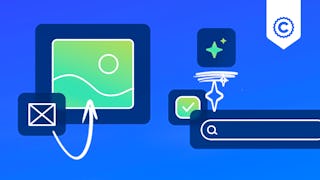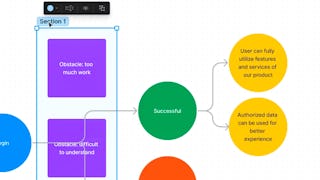Create High-Fidelity Designs and Prototypes in Figma is the fifth course in a certificate program that will equip you with the skills you need to apply to entry-level jobs in user experience (UX) design. In this course, you will follow step-by-step tutorials to learn how to create high-fidelity designs, called mockups, in Figma, a popular design tool. Then, you’ll turn those designs into an interactive prototype that works like a finished product. You’ll conduct research to collect feedback about your designs and make improvements. Finally, you’ll learn how to share your designs with development teams and highlight your work in your professional UX portfolio.

Enjoy unlimited growth with a year of Coursera Plus for $199 (regularly $399). Save now.

Create High-Fidelity Designs and Prototypes in Figma
This course is part of Google UX Design Professional Certificate

Instructor: Google Career Certificates
310,503 already enrolled
Included with
(4,764 reviews)
What you'll learn
Build mockups and high-fidelity prototypes in the design tool Figma.
Define and apply common visual design elements and principles.
Demonstrate how design systems can be used to organize, standardize, and enhance designs.
Understand the role of design critique sessions and feedback while iterating on designs.
Skills you'll gain
Details to know

Add to your LinkedIn profile
24 assignments
See how employees at top companies are mastering in-demand skills

Build your Design and Product expertise
- Learn new concepts from industry experts
- Gain a foundational understanding of a subject or tool
- Develop job-relevant skills with hands-on projects
- Earn a shareable career certificate from Google

There are 5 modules in this course
Turn your focus to visual design, which is how a product or technology appears to users. In this part of the course, you'll start to create mockups, which are high-fidelity designs that represent a final product. To create mockups, you'll use visual design elements, like typography, color, and iconography. Elements are often arranged into layouts using methods like grids, containment, and negative space. You'll apply all of these visual design learnings to build on the mobile app designs you've been working on throughout the certificate program.
What's included
16 videos23 readings4 assignments2 plugins
In this part of the course, you’ll use visual design principles to refine mockups. First, you'll use emphasis to guide users to the most important parts of a page. Next, you'll apply hierarchy, scale, and proportion to organize the elements on each page of your app. Then, you'll consider unity and variety to help elements of your app function together or stand out. Finally, you'll revisit Gestalt Principles, like similarity, proximity, and common region, to help users interpret your designs easily.
What's included
8 videos11 readings6 assignments1 plugin
Come explore the world of design systems! In this part of the course, you'll be introduced to the parts of a design system, as well as the benefits of using a design system. You'll examine various companies' design systems, and you’ll have an opportunity to use them in your own mockups. You'll also learn how to use and create sticker sheets in Figma.
What's included
9 videos5 readings4 assignments
You’re ready to build high-fidelity prototypes in Figma! Following six steps, you'll turn your mockups into a prototype that's ready for testing. In addition, you'll explore two new concepts, gestures and motion, which can help enrich the user experience and increase the usability of prototypes.
What's included
9 videos6 readings5 assignments
Now that you have a high-fidelity prototype, it’s time to test your designs. To get started, you’ll conduct a usability study to test your high-fidelity prototype of a mobile app. You'll analyze the feedback you receive to come up with actionable insights and iterate on your designs. Then, you’ll learn how to hand off designs to engineers for production. Finally, you’ll turn everything you’ve learned about user research, ideation, wireframes, designs, and prototypes into a case study for your professional UX portfolio.
What's included
12 videos13 readings5 assignments
Earn a career certificate
Add this credential to your LinkedIn profile, resume, or CV. Share it on social media and in your performance review.
Instructor

Offered by
Explore more from Design and Product
 Status: Free Trial
Status: Free Trial Status: Free Trial
Status: Free Trial Status: Free Trial
Status: Free Trial Status: Free Trial
Status: Free Trial
Why people choose Coursera for their career




Learner reviews
4,764 reviews
- 5 stars
87.49%
- 4 stars
9.96%
- 3 stars
1.55%
- 2 stars
0.44%
- 1 star
0.54%
Showing 3 of 4764
Reviewed on Mar 23, 2021
Working within Figma, you really learn a lot about the program and its benefits. The course teaches you in great detail how to successfully create hifi designs, and is packed with a ton of knowledge.
Reviewed on Aug 22, 2022
This has been an increadible course, you learn a lot about design and the different elements that are important for the user's experience. If you can take this course straight will be much easier.
Reviewed on Nov 3, 2022
The course was awesome. Detailed and step-by-step instructions.Many thanks to wonderful Trainer Kunal, I liked the way he conducted all study.Thank you Coursera and Google.
Frequently asked questions
User experience (UX) designers focus on the experience that users have while using products like websites, apps, and physical objects. UX designers make those everyday interactions useful, enjoyable, and accessible. The role of an entry-level UX designer might include coming up with ideas to address user problems, conducting research with users, and designing wireframes, mockups, and prototypes.
If you enjoy talking to and empathizing with people, drawing, thinking creatively, or paying attention to details, a job as a UX designer might be a good fit for you!
This course is the fifth of seven courses that will equip you with the skills you need to apply to entry-level jobs in user experience design. We strongly recommend that you complete the first four courses of the Google UX Design Certificate before completing this one:
- Course 1: Foundations of User Experience (UX) Design
- Course 2: Start the UX Design Process: Empathize, Define, and Ideate
- Course 3: Build Wireframes and Low-Fidelity Prototypes
- Course 4: Conduct UX Research and Test Early Concepts
Alternatively, you should have experience conducting user research in order to empathize with user needs and determine specific user pain points. You also need to have the ability to create personas, user stories, and user journey maps, as well as draft problem statements and value propositions. You need to know how to create wireframes and low-fidelity prototypes on paper and in the design tool Figma. It’s helpful to have experience conducting usability studies and iterating on designs, as well. If you are unfamiliar with any of these topics, they are covered in earlier courses of the Google UX Design Certificate.
Figma and Adobe XD are the design tools taught in the seven courses of the Google UX Design Certificate. This course focuses on creating designs in Figma.
Spreadsheets, word processing applications, and presentation applications will also be used. Throughout the program, you will create a professional portfolio, using the platform of your choice, to showcase your UX design work.
More questions
Financial aid available,





